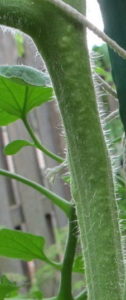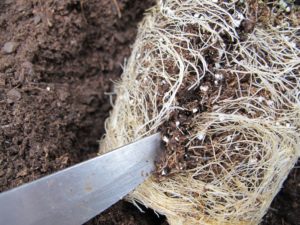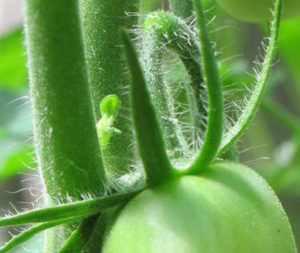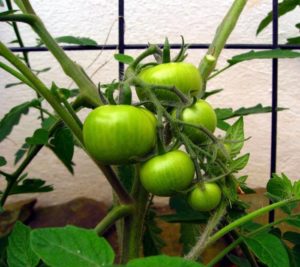Page 2
Time to Plant!
Your tomatoes and peppers are ready to be planted. Water plants prior to transplanting.
The plants that grow the tallest when mature should be planted on the north side of the plot (in the northern hemisphere). Hollow out a hole in the beautifully prepared soil a couple of feet inside the edge of the plot. You did you read “Soil Prep 101“, right?
Remove the plant by pushing the center of the bottom of the cell pack or pot. Or, holding the pot upside-down, let gravity work with you. Tap the edge of the pot on a table to help loosen the root ball from the pot.
Avoid pulling the plant by the stem, as this can tear too many roots. Inspect the roots, making sure they’re a healthy white color. If the leaves have suspicious-looking spots or brown areas of dead tissue, you might consider replacing them with healthier specimens.
Now, use a knife or a rock to gently score the outside of the root ball a few times. Slightly injuring some of the roots will stimulate new roots to quickly grow out into the enriched garden soil.
Plants with sparsely developed roots do not need to be scored.
Plant Tomatoes Deeper

Root initials.
The tomato is one of few plants that can be planted deeper than the top of the root ball. The stem below ground will soon grow roots from root initials, the light green bumps on the stem (photo, right). Although many are alarmed by their appearance, I’ve never grown a tomato that didn’t have them. Perfectly normal in a healthy plant.
I have seen 3′ tall, leggy tomato plants that have been planted with all of the stem placed below ground and parallel to the soil surface, with only a few leaves above ground, and they prospered. Remember—they’re weeds!
I have also witnessed gardeners absolutely mangling the root system only to later see the plant fully recovered. A tomato plant will do that; other vegetables are less forgiving.
A stressed transplant facing the blazing sun might wilt because the roots simply can’t supply enough water to the top of the plant. Place an old plastic chair over the transplant, or shade it in some other way. Or plant in the evening so it can settle in overnight. And don’t mangle the root system! Tomato roots grow quickly and will soon recover.
Other Crops
Plant peppers and eggplants with the top of the root ball flush with the surrounding soil.
Young broccoli, cabbage, and other plants in the brassica family can be planted about an inch deeper; roots will emerge from the tender stems. Make it easier for them by not firming the soil too hard against the stem. If the plants are a bit older, don’t cover the tougher stems.
Trichomes
Most plants have tiny hairs growing from the epidermis. Two kinds of hairs you see on stems and leaves of a tomato plant are called glandular trichomes and multicellular trichomes. Sticky glandular trichomes hold that characteristic tomato smell and help fend off insect intruders.
These curious appendages have complicated chemistries and perform different functions in various plants. An analysis of basil trichomes shows that they contain over 880 proteins! These hairs carry the characteristic scents that we recognize, for example, in mint, lavender, and geranium. Trichomes hold moisture and mitigate wind speed close to the plant in what is known as the boundary layer.
I don’t believe the little hairs grow into roots, as the root initials do, when stems are planted below the soil surface, as many claim. Trichomes are not the same as the fine root hairs that grow from the epidermis of the root in the maturation zone, near the root tip.
Stake or Cage a Tomato Plant?
If you have tomato cages, place them around the plants after planting them. You can find all sorts of suppliers who sell tall, attractive, collapsible cages. The metal cages that are only a few feet tall are good for peppers, eggplants, bush beans, and the shorter, determinate varieties of tomatoes. You might get the young ones interested in the project by letting them choose cages in their favorite colors.
I use 7′ or 8′ tall vinyl-clad metal or wooden stakes, mainly because they take up little room in storage. Hammer the stake far enough into the ground, a few inches from the stem, to anchor it securely. You could “plant” the stake before you put the transplant into the ground to prevent damage to the plant. A tall trellis (photo, above) will work as well.
It won’t be long before the plant triples in height, so have the twist-ems or twine ready. Don’t secure them too tightly; this will constrict the stems as they grow. Wind a few lengths around the stake or the trellis when you plant, just to have them at hand when you need them.
Familiarize yourself with the growth habits of the varieties you’re going to grow. Look online, in catalogs, or ask the grower for information. It’s helpful to know if a tomato plant will grow to 4′ or 8′ in height.
Cutting back the tops of tall vines near the end of the season might hasten the ripening of remaining fruits.
And Water
With a watering can or a well-controlled garden hose, gently water in the new tomato plant. Give the original root ball and the surrounding soil a good drink, but you don’t need to saturate the entire plot just now.
Some gardeners like to water in the young plants with a mild fertilizer solution. You can use diluted fish emulsion or any other transplant formula. Well-amended soil does not need fertilizer at this time. Later, as the roots expand, you will need to water more broadly and deeply. And in 2-3 weeks, you’ll need to start fertilizing the plants on a regular basis.
Place an airy mulch, such as pine bark nuggets or pine straw, under and around the plants. Mulch not only keeps the foliage cleaner, but it also suppresses weeds, keeps the soil cooler, and retains moisture. It also prevents “soil splash”, which could deposit dormant disease spores from the soil onto the plants.
Deer

There are certain forms of wildlife that are inclined to enjoy your vegetable garden as much as you do. If enclosing the back yard with an 8′ tall fence is in the budget, great!
 Deer are not likely to jump over a fence if they can’t see where they’re going to land. So, if you have a solid 6′ or 6 1/2′ fence, your garden probably will be okay. You could add some height by building a decorative trellis on top of an existing fence. Or simply attach wires strung from one support to another.
Deer are not likely to jump over a fence if they can’t see where they’re going to land. So, if you have a solid 6′ or 6 1/2′ fence, your garden probably will be okay. You could add some height by building a decorative trellis on top of an existing fence. Or simply attach wires strung from one support to another.
Use deer netting (photo, right) and tall stakes to construct a roomy cage for your tomato plant. If the dimensions are too small, the fast-growing stems will become hopelessly entangled in the netting.
We who are familiar with the appetites of deer and rabbits are quick to advise, “Put something in place now!” No, really, I highly recommend placing barriers in their way if deer and rabbits live in the neighborhood.
Page 1: It’s Time To Plant Tomatoes!, How Much Sun For a Tomato Plant? (Options), More Light For a Tomato Plant, Crop Rotation, Disease Resistance, Disease Prevention For a Tomato Plant (Air Circulation and Suckers, When Disease Strikes), and Sun Scald (On Peppers, Tomatoes Exposed To Sun)
Page 2: Time to Plant!, Plant Tomatoes Deeper, Trichomes, Stake or Cage a Tomato Plant?, And Water, and Deer



